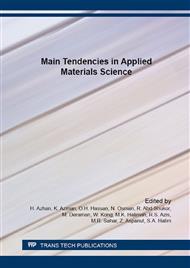p.459
p.465
p.471
p.479
p.484
p.493
p.497
p.505
p.510
Ultra-Sensitive Breath Sensor Device for Sleep Disorder Monitoring and Clinical Studying
Abstract:
Sleep disorder study by means of polysomnography (PSG) is the most well adopted and reliable procedure in medical practice. The present-day sleep monitoring devices for the PSG procedure is equipped with relatively expensive apparatus and technically complex modus operandi. Thus the PSG procedure must be conducted by well trained personnel. This study is about development of an ultra-sensitive breath sensor for medical procedures. The miniature size breath sensor design gives an added advantage on the final design of the sleep monitoring device for sleep disorder study or personal therapy. This solid state breath sensor is structured with micro tungsten inter-digitated electrode (IDE) platform that covered with multi-walled carbon nanotubes (MWCNT) as sensing material. The MWCNT is grown on a thin oxide layer on top of the tungsten IDE using plasma enhance chemical vapor deposition (PECVD) technique. These MWCNT structures are capable of sensing and capturing breathing behavior thus a quick response capacitive sensor is developed. Typical photolithography and sputtering processes are involved in the sensor structure fabrication. A customized test jig imitating a human like breathing pulse was fabricated to test the sensor’s performance in relation to sensitivity and response time. Human subjects are used as well to further confirm the breath sensor performance. The research study shows this newly developed breath sensor device is highly sensitive and shows remarkably fast response; within sub-second.
Info:
Periodical:
Pages:
484-489
Citation:
Online since:
March 2016
Authors:
Price:
Сopyright:
© 2016 Trans Tech Publications Ltd. All Rights Reserved
Share:
Citation:


